lecture 3---
【精选】Lecture-3---模型算法控制-MAC-幻灯片
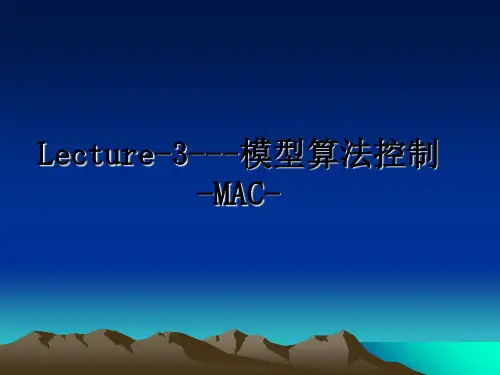
u(k) dT Yr (k) G2U2(k) he(k)
模型匹配情况(即没有模型误差)
当e(k) 0(即gi gˆi ), u(k) dT Yr (k) G2U2(k)
y(1)h0u(1)h1u(0)
k
y(2)h0u(2)h1u(1)h2u(0)
k
y(k) hiu(ki)
y(k)h0u(k)h1u(k1) hku(0) hiu(ki)
i0
i0
5
预备知识
System
u(k)
y(k)
u { u ( 0 )u ( 1 ) u ( k ) } y { y ( 0 )y ( 1 ) y ( k )
3
预备知识
System
u(k)
y(k)
u ( k ): { 100} y { h ( k ) } { h 0h 1h 2 }
u { u (0 )00 }y { h 0 u ( 0 )h 1 u ( 0 )h 2 u ( 0 ) }
u { 010 }
y { 0h 0 h 1 h 2 }
u { 0u (1 )0 } y { 0 h 0 u ( 1 )h 1 u ( 1 )h 2 u ( 1 ) }
u { 0 0u ( k )0}y {0 h 0 u ( k )h 1 u ( k )h 2 u ( k ) }
u { u ( 0 )u ( 1 ) u ( k ) } y:{y(k)}?
4
预备知识
u { u(0 )00 } y { h 0 u (0 )h 1 u (0 )h 2 u (0 ) }
w
参考轨迹
yr (k i)
+
u (k )
y (k )
优化计算
lecture_3---耦合
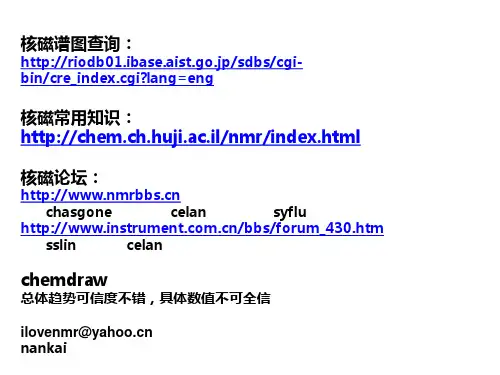
A
J
A
X
irrad at X X
X( )
X( )
A( )
A( )
Decoupling of 13C NMR
更简单的谱线
更高的信噪比
OH
OH
O
Decoupling of 13C NMR
1H-1H三键耦合---Karplus
Ha
Equation
Jab Jad
Jac
远程耦合
跨越四根键及更远的偶合称为长程偶合, 偶合常数一般小于1Hz。但 是, 对于连结偶合核的键在空间中呈固定‘ W ’构型的分子。
远程耦合
H
4
H
5
H
C
C
C
H
4J H1-H3 5J H1-H4
= 1.07 Hz = 1.21 Hz = 0.95 Hz
H-D一键耦合常数为6.5Hz,二、三键耦合常数为1-2Hz。 I=1/2 可将质子裂分为N+1个峰 一键耦合常数为几十到一百几十,
19F
三氟丙酮中氟对甲基质子的四键耦合常数仍然有4.3Hz。
31P
I=1/2 可将质子裂分为N+1个峰 一键耦合常数为200-700Hz,二键耦合常数为0.5-20Hz。
I
S
I
S
耦合常数 J (Hz)
耦合常数的值与谱仪频率无关
原子核间的耦合---N+1(2I+1)规律
b Ib S I aIbS S I S bIaS
aIaS
aa ab ba bb CH3
aaa aab aba baa abb bab bba bbb CH2
(英文)细胞生物学lecture3-生物膜的选择透过性
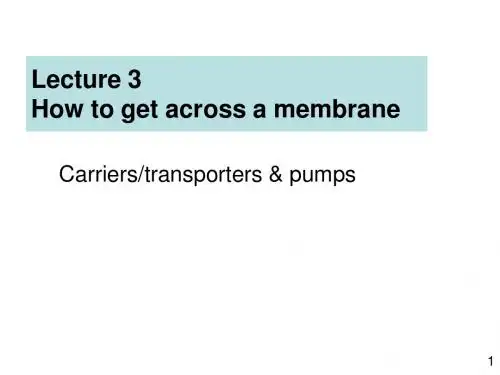
No ion flow
Membrane potential is 0
Ions would cross the membrane if allowed (if a channel was open) There is a membrane potential
13
Ion distribution across cell membranes
5
Carrier-mediated transport is saturable
When all substrate binding sites are filled: maximal transport rate (vmax) vmax depends on how fast the carrier can flip between its two conformational state
11
How can we test experimentally whether mutations in GLUT1 prevent glucose transport?
Step 1: Extract GLUT1 Step 2: Reconstitute in liposome from membrane 1. extract the transporter from the membrane using detergents
2
Which proteins mediate molecule transport across a membrane?
3
How does a carrier/transporter work?
• One or more specific binding sites for the solute • Ligand binding induces conformational change in the transporter conformational change is the rate limimation and conformational changes
lecture3
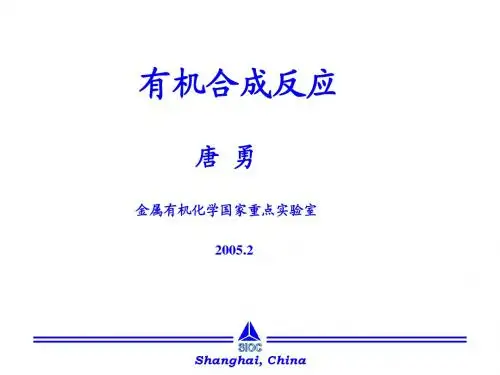
Me
Wojtkowski, JOC 1971, 1790.
Shanghai, China
• Base-induced Reactions
Aldol-type reactions:
O R N2
LDA is the optimal base for lithiation
Shanghai, China
§ 4-1 Some Reactions of Nitro Compounds
Stabilized carbanion Transformation of the -NO2 group
NO2 R
Other reactions
-NO2 as a Leaving Group
Me O
Me O
Me
Smith, JACS, 1981, 2009.
Me
Rearrangement:
OO N2
BF3 OEt 2
O N2
N2
O
R
Mander, Aust. J. Chem. 1979, 1975.
OBF 3 R
R
O
Shanghai, China
• Ring Expansion Reactions:
Shanghai, China
• Nucleophilic Addition
OH O R NO 2 + H R R3N EtOH NO 2 R
+ n
R R
O
R NO 2
H2N(CH 2)2NMe 2 Benzene, 80oC
NO 2
n NO 2
+ H2N(CH 2)2NMe 2 Benzene, 80oC
遗传学Lecture 3减数分裂
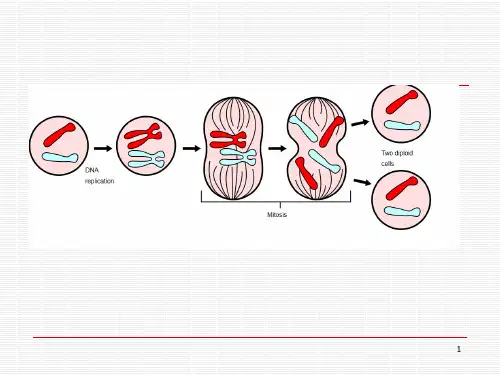
(二)减数分裂II
减数分裂I完成后进入间期,间期很短,相当于 有丝分裂的间期,有的无间期,DNA不复制, 很快进入第二次减数分裂,其过程与一般有丝 分裂十分相似,可分前期、中期、后期、末期。
11
前期
中期
后期
末期 四分孢子
四分孢子
性细胞形成过程中,每个性母细胞经过减数分 裂形成4个子细胞,子细胞内的染色体数目只 有原来性母细胞的一半,在植物中刚形成的细
15
非姐妹染色单 体之间的交换
有
无
16
有丝分裂和减数分裂的对比视频网址
/v_show/id_XMTczNDk0OTQw.html?from=y1.7-1-87.4.16-1.8-1-2-15
18
19
20
21
22
遗传的染色体理论
The Boveri–Sutton chromosome theory (also known as the chromosome theory of inheritance or the Sutton–Boveri theory) is a fundamental unifying theory of genetics which identifies chromosomes as the carriers of genetic material (1902).
1
减数分裂中染色体变化规律是1883年由 E.van贝内登在动物和1888年由E.A.施特 拉斯布格在植物最初发现的。
二、减数分裂和遗传
减数分裂(meiosis)又称成熟分裂,是一特殊
的有丝分裂。特殊性表现于:仅发生于生殖细 胞。包括两次连续分裂。
2
(一)减数分裂Ⅰ
前期、中期、后期、末期四个时期
稳定性与鲁棒性lecture3——鲁棒控制基础
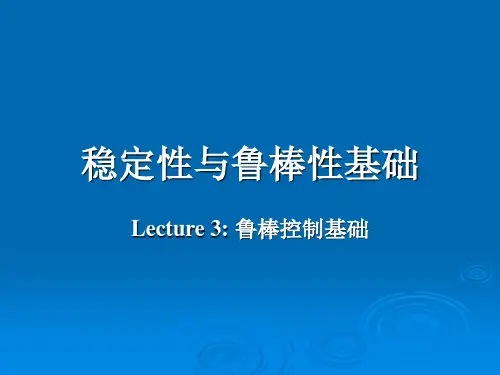
u G(s)
y
N1 ( s ) G ( s) , D1 ( s )
N 2 ( s) H ( s) D2 ( s )
闭环传函
F ( s) G( s) H ( s) 1 G( s) H ( s)
通过F(s)的极点分布,判断系统的稳定性。 也就是研究1+G(s)H(s)=0 的根,即 D1(s)D2(s)+N1(s) N2(s)=0 的根的情况
W(s) K(s) P(s)
w1
Ws(s) _ r
u
+
控制目标:尽量减少跟踪误差,即
由w1到e的传函
1 Ws ( s ) I [ P( s) ( s)W ( s)]K ( s)
1
确保鲁棒稳定性: W (s) P(s) K (s)S (s) 1 其中 S ( s)
1 I P( s) K ( s )
P( s)
1
(3) 反馈不确定性
ΔP(s) _ + P0(s) W(s)
P( s)
P ( s) 0 , 1 P( s )W ( s ) P ( s ) 0
ΔP(s) _
P( s )
1
W(s)
P0(s)
+
P ( s) 0 P( s ) , 1 P( s )W ( s )
所以标称模型只能是实际物理系统的不 在外界干扰或系统模型发生变化时系统性能的保 持能力; 鲁棒控制:按照鲁棒性要求设计的控制方案叫做鲁棒控制; 鲁棒系统设计的目标:就是要在模型不精确和存在其他变 化因素的条件下,使系统仍能保持预期性能。 如果模型的变化和模型的不精确不影响系统的稳定性和其 它动态性能,这样的系统我们称它为鲁棒控制系统。 鲁棒控制理论:鲁棒性分析问题和鲁棒性综合问题
lecture3
Lecture3-Axioms of Consumer Preference and the Theory ofChoiceDavid Autor14.03Fall2004Agenda:1.Consumer preference theory(a)Notion of utility function(b)Axioms of consumer preference(c)Monotone transformations2.Theory of choice(a)Solving the consumer’s problemIngredientsCharacteristics of the solutionInterior vs corner solutions(b)Constrained maximization for consumer(c)Interpretation of the Lagrange multiplierRoad map:Theory1.Consumer preference theory2.Theory of choice3.Individual demand functions4.Market demandApplications1.Dead weight loss of Christmas2.Food stamps and other taxes and transfers3.Gi¤en goods:Theory and evidence1Consumer Preference TheoryA consumer’s utility from consumption of a given bundle“A”is determined by a personal utility function.1.1Cardinal and ordinal utilityCardinal Utility FunctionAccording to this approach U(A)is a cardinal number,that is:U:consumption bundle !R1measured in“utils”Ordinal Utility FunctionMore general than cardinal utility functionU provides a“ranking”or“preference ordering”over bundles.U:(A;B) !8<:A P B B P A A I BUsed in demand/consumer theoryCardinal vs Ordinal Utility FunctionsThe problem with cardinal utility functions comes from the di¢culty in…nding the appropriate measurement index(metric).Example:Is1util for person1equivalent to1util for person2?Or if we increase a person’s utility from1to2,is she twice as happy?By being unit-free ordinal utility functions avoid these problems.What’s important about utility functions is that it allows us to model how people make personal choices, that is,how they choose among competing alternatives.We do not’t need to know how many“utils”people experience from each choice to answer this question;we just need to know how they rank choices.Note:It’s much harder to model interpersonal comparisons of utility1.2Axioms of Consumer Preference TheoryCreated for purposes of:ing mathematical representation of utility functions2.Portraying rational behavior(rational in this case means‘optimizing’)3.Deriving“well-behaved”demand curves1.2.1Axiom1:Preferences are Complete(“Completeness”)For any two bundles A and B,a consumer can establish a preference ordering.That is,for any comparison of bundles,she will choose one and only one of the following:1.A P B2.B P A3.A I BWithout this property,preferences are unde…ned.1.2.2Axiom2:Preferences are Transitive(“Transitivity”)For any consumer if A P B and B P C then it must be that A P C:Consumers are consistent in their preferences.1.2.3Axiom3:Preferences are Continuous(“Continuity”)If A P B and C lies within an"radius of B then A P C.We need continuity to derive well-behaved demand curves.Given Axioms1-3are obeyed we can always de…ne a utility function.Any utility function that satis…es Axioms1-3cannot have indi¤erence curves that cross.Indi¤erence Curves De…ne a level of utility say U(x)=U then the indi¤erence curve for U,IC(U)is the locus of consumption bundles that generate utility level U for utility function U(x).An Indi¤erence Curve Map is a sequence of indi¤erence curves de…ned over every possible bundle and every utility level:f IC(0);IC(");IC(2");:::g with"=epsilonUtilsGood xGood yIC (2D)Utility function (3D)Graph 25Indi¤erence curves are level sets of this utility function.xyIC 3IC 2IC 1IC 3 !Utility level U 3IC 2 !Utility level U 2IC 1 !Utility level U 19=;U 3>U 2>U 1This is called an Indi¤erence Curve Map Properties:Every consumption bundle lies on some indi¤erence curve (by the completeness axiom) INDIFFERENCE CURVES CANNOT INTERSECT (by the transitivity axiom)Proof:say two indi¤erence curves intersect:Good yAccording to these indi¤erence curves:A P BB I CC P DD I ABy the above mentioned axioms:A P D and A I Dwhich is a contradiction.Axioms4.and5.are introduced to re‡ect observed behavior.They simplify problems greatly,but they are not necessary for a theory of rational choice.1.2.4Axiom4:Non-Satiation(Never Get Enough)Given two bundles,A and B,composed of two goods,X and Y.X A=amount of X in A,similarly X BY A=amount of Y in A,similarly Y BIf X A=X B and Y A>Y B(assuming utility is increasing in both arguments)then A P B(regardless of the levels of X A;X B;Y A;Y B)This implies that:1.The consumer always places positive value on more consumption2.Indi¤erence curve map stretches out endlessly(there is no upper limit to utility)1.2.5Axiom5:Diminishing Marginal Rate of SubstitutionIn order to de…ne this axiom we need to introduce the concept of Marginal Rate of Substitution and some further preliminary explanations.De…nition:MRS measures willingness to trade one bundle for another.Example:Bundle A=(6hours of sleep,50points on the problem set)Bundle B=(5hours of sleep,60points on the problem set)A andB lie on the same indi¤erence curveA student is willing to give up1more hour of sleep for10more points on the problem set.Her willingness to substitute sleep for grade points at the margin(i.e.for1fewer hours of sleep)is: 101= 10MRS(sleep for points)=j 10j=10MRS is measured along an indi¤erence curve and it may vary along the same indi¤erence curve.If so,we must de…ne the MRS relative to some bundle(starting point).dU=0along an indi¤erence curveTherefore:0=@U@xdx+@U@ydy0=MU x dx+MU y dydy dx=MU xMU y=MRS of x for yMRS must always be evaluated at some particular point(consumption bundle)on the indi¤erence curve.MRS of x for y decreases as we go down on the indi¤erence curve.This indi¤erence curve exhibits diminishing MRS:the rate at which(at the margin)a consumer is willing to trade x for y diminishes as the level of x consumed goes up.That is the slope of the indi¤erence curve between points B and C is less than the slope of the curve between points A and B.Diminishing MRS is a consequence of Diminishing Marginal Utility.A utility function exhibits diminishing marginal utility for good x when MU x decreases as consumption of x increases.A bow-shaped-to-origin(convex)indi¤erence curve is one in which utility function has diminishing MU fory Graph 29bothThis implies that consumer prefers diversity in consumption.An alternative de…nition of diminishing MRS can be given through the mathematical notion of convexity.De…nition:a function U(x;y)is convex if:U( x1+(1 )x2; y1+(1 )y2) U(x1;y1)+(1 )U(x2;y2)Suppose the two bundles,(x1;y1)and(x2;y2)are on the same indi¤erence curve.This property states that the convex combination of this two bundles is on higher indi¤erence curve than the two initial ones.Graph 30yx 2x 1y 2yx*y*where x = x 1+(1 )x 2and y = y 1+(1 )y 2.This is veri…ed for every 2(0;1).The following is an example of a non-convex curve:Graph 31y 2y 1x 2x 1y xIn this graph not every point on the line connecting two points above the curve is also above the curve,therefore the curve is not convex.Q:Suppose co¤ee and sushi have the same quality:the more you consume,the more you want.How do we1.3Cardinal vs Ordinal UtilityA utility function of the form U(x;y)=f(x;y)is cardinal in the sense that it reads o¤“utils”as a function of consumption.Obviously we don’t know what utils are or how to measure them.Nor do we assume that10utils is twice as good as5utils.That is a cardinal assumption.What we really care about is the ranking(or ordering)that a utility function gives over bundles of goods. Therefore we prefer to use ordinal utility functions.We want to know if A P B but not by how much.However we do care that the MRS along an indi¤erence curve is well de…ned,i.e.we do want to know precisely how people trade o¤among goods in indi¤erent(equally preferred)bundles.Q:How can we preserve properties of utility that we care about and believe in(1.ordering is unique and2. MRS exists)without imposing cardinal properties?A:We state that utility functions are only de…ned up to a“monotonic transformation”.De…nition:Monotonic TransformationLet I be an interval on the real line(R1)then:g:I !R1is a monotonic transformation if g is a strictly increasing function on I.If g(x)is di¤erentiable then g0(x)>08xInformally:A monotone transformation of a variable is a rank-preserving transformation.[Note:not all rank-preserving transformations are di¤erentiable.]Examples:Which are monotone functionsLet y be de…ned on R1:1.x=y+1[yes]2.x=2y[yes]3.x=exp(y)[yes]4.x=abs(y)[no]5.x=y2if y 0[yes]6.x=ln(y)if y>0[yes]7.x=y3if y 0[yes][yes–but unde…ned if y=0]8.x= 1y9.x=max(y2;y3)if y 0[yes]10.x=2y y2[no]Property:If U2(:)is a monotone transformation of U1(:),i.e.U2(:)=f(U1(:))where f(:)is monotone in U1as de…ned earlier,then:–U1and U2exhibit identical preference rankings–MRS of U1(U)and U2(U)=)U1and U2are equivalent for consumer theoryExample:U(x;y)=x y (Cobb-Douglas)U0U1U2xyWhat is the MRS along an indi¤erence curve U0?U0=x 0y 0dU0= x 10y 0dx+ x 0y 1dydydx U=U0= x 10y 0 x 0y 10= y0x0=@U=@x@U=@y Consider now a monotonic transformation of U:U1(x;y)=x yU2(x;y)=ln(U1(x;y))U2= ln x+ ln yWhat is the MRS of U2along an indi¤erence curve such that U2=ln U0?U20=ln U0= ln x0+ ln y0dU20=x0dx+y0dy=0dy U2=U20= y00=@U=@xwhich is the same as we derived for U1.How do we know that monotonic transformations always preserve the MRS of a utility function?Let U=f(x;y)be a utility functionLet g(U)be a monotonic transformation of U=f(x;y)The MRS of g(U)along an indi¤erence curve where U0=f(x0;y0)and g(U0)=g(f(x0;y0)) By totally di¤erentiating this equality we can obtain the MRS.dg(U0)=g0(f(x0;y0))f x(x0;y0)dx+g0(f(x0;y0))f y(x0;y0)dydy dx g(U)=g(U0)=g0(f(x0;y0))f x(x0;y0)g0(f(x0;y0))f y(x0;y0)=f x(x0;y0)f y(x0;y0)=@U=@x@U=@ywhich is the MRS of the original function U(x;y).。
Lecture 3 形式的复活
Dolphins were far hornier than Flipper ever let on; randy males had even been known to attempt couplings with human females.(Chromosome 8)
其实海豚很好色的,甚至比电视上的Flipper注还要过分,据说好色的雄性海豚还想和女人结合呢。
文学性
文学性是语言通过一定的排列组合造就的。这种排列组合是有规律的,这规律就是对语言运用的常规的故意违反,造成形式上的变异,从而形成陌生化或反常化(defamiliarization)的形式特征
读者在解读这些新颖乃至费解的形式特征进而获得理解的过程就是诗学所追求的审美或诗学效果。
三、“亡者”归来
后结构主义更加强调形式
案例3
The lip of the sun curled over the horizon to blow a red glow across the island.
太阳从天边升起,小岛沐浴在一片一片红色的朝霞之中
改译
太阳在地平线上撅起一弯唇瓣,向着小岛吹了一口红色的光。
案例4
The fault-finder will find faults in paradise.(Love Your Life)
(注:Flipper是1964年在美国播出的一套长篇电视剧,剧中的主角是一条名叫Flipper的海豚。)
改译
海豚其实是很好色的,比那个费利波[注略]好色多了,据说那些雄性的海豚骚劲上来了连雌性的人都想勾搭呢。
案例2
You hear it all along the river. You hear it, loud and strong, from the rowers as they urge the junk with its high stern, the mast lashed alongside, down the swift running stream. You hear it from the trackers, a more breathless chant, as they pull desperately against the current…(The Song of the River)
商务英语课程讲义 - Lecture 3-打印50
Lecture 3ReadingArticle A - Company structure[1]The chain of commandTraditionally, organizations have had a hierarchical or pyramidal structure, with one person or a group of people at the top, and an increasing number of people below them at each successive level. This is sometimes called line structure. There is a clear chain of command running down the pyramid. All the people in the organization know what decisions they are able to make, who their line manager (or boss) is(to whom they report), and who their immediate subordinates are (over whom they have line authority, and can give instructions to).[2]Functional structureYet the activities of most organizations are too complicated to be organized in a single hierarchy. Most large manufacturing companies, for example, have a functional structure, including, among others, specialized production, finance, marketing, sales, and human resources departments. This means, for instance, that the production and marketing departments can not take financial decisions without consulting the finance department. Large organizations making a range of products are often further divided into separate operating divisions.A disadvantage of functional organization is that people are often more concerned with the success of their own department than that of the company as a whole, so there are permanent conflicts between, say, finance and marketing or marketing and production over what the objectives are.[3]Flattening hierarchies and delegating responsibilityA problem with very hierarchical organizations is that people at lower levels can’t take important decisions, but have to pass on responsibility to their boss. However, the modern tendency is to reduce the chain of command, take out layers of management, and make the organization much flatter. Advanced IT systems have reduced the need for administrative staff and enabled companies to remove layers of workers from the structure. Many companies have also been forced to cut back and eliminate jobs in recessions. Typically, the owners of small firms want to keep as much control over their businesses who want to motivate their staff often delegate decision making and responsibilities to other people.[4]Matrix managementAnother way to get round hierarchies is to use matrix management, in which people report to more than one superior. For example, a product manager with an idea could deal directly with the managers responsible for a certain market segment and for a geographical region, as well as managers inthe finance, sales and production departments. Matrices involving several departments can become quite complex, so it is sometimes necessary to give one department priority in decision making.[5]TeamsA further possibility is to have wholly autonomous, temporary groups or teams that are responsible for an entire project, and are split up as soon as it is successfully completed. But teams are not always very good at decision making, and usually requires a strong leader.Article B - Hard Sell around the Photocopier[1]Sociologists have long recognized that businesses of less than 200 individuals can operate through the free flow of information among the members. Once their size exceeds this figure, however, some kind of hierarchical structure or line management system is necessary to prevent total chaos resulting from failures of communication. Imposing structures of this kind has its costs: information can only flow along certain channels because only certain individuals contact each other regularly;moreover, the lack of personalized contacts means that individuals lack that sense of personal commitment that makes the world of small groups go round. Favors will only be done when there is a clear quid pro quo, an immediate return to the giver, rather than being a matter of communal obligation. Large organizations are less flexible.[2]One solution to this problem would, of course, be to structure large organizations into smaller units of a size that can act as a cohesive group. By allowing these groups to build reciprocal alliances with each other, larger organizations can be built up. However, merely having groups of say, 150 will never of itself be a panacea to the problems of the organization. Something else is needed: the people (involved) must be able to build direct personal relationships. To allow free flow of information, they have to be able to interact in a casual way. Maintaining too formal a structure of relationships inevitably inhibits the way a system works.[3]The importance of this was drawn to my attention a couple of years ago by a TV producer. The production unit for which she worked produced all the educational output for a particular TV station.Whether by chance or by design, it so happened that there were almost exactly 150 people in the unit. The whole process worked very smoothly as an organiztion for many years until they were moved into purpose-built accommodation. Then for no apparent reason, everything started to fall apart. The work seemed to be more difficult to do, not to say less satisfying.[4]It was some time before they worked out what the problem was. It turned out that, when the architects were designing the new building, they decided that the coffee room where everyone ate their sandwiches at lunch times was an unnecessary luxury and so dispensed with it.The logic seemed to be that if people were encouraged to eat their sandwiches at their desks, then they weremore likely to get on with their work and less likely to idle time away. And with that, they inadvertently destroyed the intimate social networks that empowered the whole organization. What had apparently been happening was that as people gathered informally over their sandwiches in the coffee room, useful snippets of information were casually being exchanged. Someone had a problem they could not solve, and began to discuss it over lunch with a friend from another section. The friend knew just the person to ask. Or someone overhearing the conversation would have a suggestion, or would go away and happen to bump into someone who knew the answer a day or so later; a quick phone call and the problem was resolved. Or a casual comment sparked an idea for a new program.[5]It was these kinds of chance encounter in the coffee room, idle chatter around the photocopier, that made the difference between a successful organization and a less successful one.Business Vocabulary in Use- Voc Exercises3.1 Look at the executives and managers listed in A above. Match each task(1-6) with the particular person most likely to be responsible for doing it.1.Meet with advertising agency to discuss new advertisements for thecompany’s holidays.2. Study possible new holiday destinations in detail.3. Analyze last year’s profits in relation to the previous year’s.4. Contact newspaper to advertise new jobs.5. Deal with complaints from customers.6. Discuss sales figures with sales team.3.2 Who’s who on this company board? Look at B above and complete theDiagram.My name’s Maria Montebello, and I’m president and CEO. We have some excellent people on our board, including two who are not involved in day-to-day running of the company: George Gomi and Julia Jones.My name’s Stan Smith and it’s my job to look after the accounts. I work closely with Clarissa Chang and Richard Roberts, as they tell me what their departments need for marketing and research, and I allocate them an annual budget.My name’s Deirdre Dawes and I head up personnel, on the same level in the company as Clarissa Chang and Richard Roberts.1Maria Montebello 2Non-executive director35 6 7。
Lecture 3-final
确实,吸烟危害人们的健康,并且它侵犯 了不吸烟者的权力和自由。然而,我认为不 应该完全禁止吸烟,原因如下。
We must admit that smoking is detrimental to people’s health. However, the harm that smoking brings to people’s health is exaggerated. 我们必须承认吸烟对人们的健康是有害的。 然而,吸烟给人们健康带来的伤害是被夸大 了。
结尾段
To sum up, I do not think that smoking should be completely banned. Tobacco industry makes much contribution to the national economy. Smoking brings many psychological benefits to smokers. Moreover, the complete ban of smoking will give rise to many social problems.
理由段 3
We must admit that smoking is detrimental (有害的) to people’s health. However, the harm that smoking brings to people’s health is exaggerated (夸张, 夸大). As long as we smoke in moderation (适度的, 适量的), it will not do great harm to our health. In history, many famous people, such as Sir Winston Churchill, smoked and enjoyed a long life expectancy (长寿).
- 1、下载文档前请自行甄别文档内容的完整性,平台不提供额外的编辑、内容补充、找答案等附加服务。
- 2、"仅部分预览"的文档,不可在线预览部分如存在完整性等问题,可反馈申请退款(可完整预览的文档不适用该条件!)。
- 3、如文档侵犯您的权益,请联系客服反馈,我们会尽快为您处理(人工客服工作时间:9:00-18:30)。
• Export customs clearance
– Usu. buyer’s responsibility, sometimes seller do it for buyer, but bear no risks
EXW
Carriage of goods
Carriage to be arranged by the buyer
;
FCA EXW
Port of Terminal destination
the E-term
• EXW/Ex Works (d place)
– the seller fulfills his obligation to deliver when he has make the goods available at his premises. (i.e. works, factory, warehouse, etc.) to the buyer. – Seller’s obligation min. – For the buyer to get lower price, but too demanding for him, therefore only applied to buyers having offshore branches
– the seller is paying for the necessary handling of goods until they are loaded on board the vessel.
The “C” terms (CFR, CIF, CPT, CIP)
• Mode of Transportation:
Carriage and Insurance Paid to (…named place of destination) 运费保险费付至( …指定目的地)
Arrival
Delivered at Terminal (…named terminal at the port or place of destination) Delivered at Place (…named place of destination) 目的地交货(…目的港或目的地指定地 点) 所在地交货( …指定目的地)
DDP
Delivered Duty Paid (…named place of destination)
完税后交货( …指定目的地)
Incoterms 2010 Wallchart
DDP DAP DAT CIP CPT CIF CFR FOB FAS Risks Obligation & Costs Insurance Empty Loaded Seaway and inland waterway only Alongside On board the vessel the vessel Any mode Seller’s premises 1st carrier Place of destination
– Seller: exporting license and export customs clearance – Buyer: importing license and import customs clearance
FCA Free Carrier (…. Named place)
• Transfer of risks
• Transportation:
– FAS & FOB only for sea or inland waterway transportation mode – FCA for any mode of transportation
the F-terms (FCA, FAS, FOB)
• Seller’s obligation, cost and risk transfers to buyer after delivery of the goods
FOB Free on Board (… named port of
shipment)
• Delivery point: at port of shipment • Transfer of risks:
– goods placed on board the seagoing vessel
• Cost and obligation:
– goods at the disposal of the (1st) carrier
• Delivery point
– If at seller’s site, seller is responsible for loading – If anywhere else, seller responsible for delivering the goods to the point required, but not responsible for unloading or reloading
Main Carriage paid
Cost and Freight (…named port of destination) Cost, Insurance and Freight (…named port of destination) Carriage Paid to (…named place of destination) 成本加运费( …指定目的港) 成本、保险费加运费( …指定目的港) 运费付至( …指定目的地)
• price, risks of loss shift from the seller to the buyer
Group E EXW Group F FCA
Departure
Ex Works (…named place) 工厂交货( …指定地点)
Main Carriage unpaid
Free Carrier (…named place) 货交承运人(…指定地点)
– CFR&CIF: only for sea or inland waterway
• Under CIF and CIP, seller also takes out insurance and insurance cost.
• Two “critical” points
– Port (place) of shipment – to which the buyer takes over the risks – Port (place) of destination – to which the seller is bound to arrange and bear the costs of a contract of carriage
CFR Cost and Freight (… named port of
destination)
• Shares every feature with FOB except for ocean freight charge • Freight at seller’s cost
– Seller pay the normal transport cost for the carriage of the vessel by a usual route and in a customary manner to the agreed place – Buyer take the risk of loss or damage to the goods and additional costs resulting from events occurring after the delivery of the goods
2.3 Table Filling
2.4 Application Issues
trade terms
• price terms/ delivery terms
• standardized terms used in sales contracts that describe the place and manner for the transfer of goods from the seller to the buyer.
risks
costs
Risk transfer from the seller to the buyer when the goods are at the disposal of the buyer
Cost transfer from the seller to the buyer when the goods are at the disposal of the buyer
Lecture 3
Chapter One General Introduction and Incoterms 2010
Outline
1. Export Procedures 2. Incoterms
2.1 Basics of Incoterms
2.2 Trade Terms in Incoterms 2010
Carriage of goods
risks
costs
FCA
Carriage to be arranged by the buyer or the seller on the buyer's behalf Risk transfer from the seller to the buyer when the goods have been delivered to the carrier at the named place Cost transfer from the seller to the buyer when the goods are at the disposal of the buyer
the E-term
